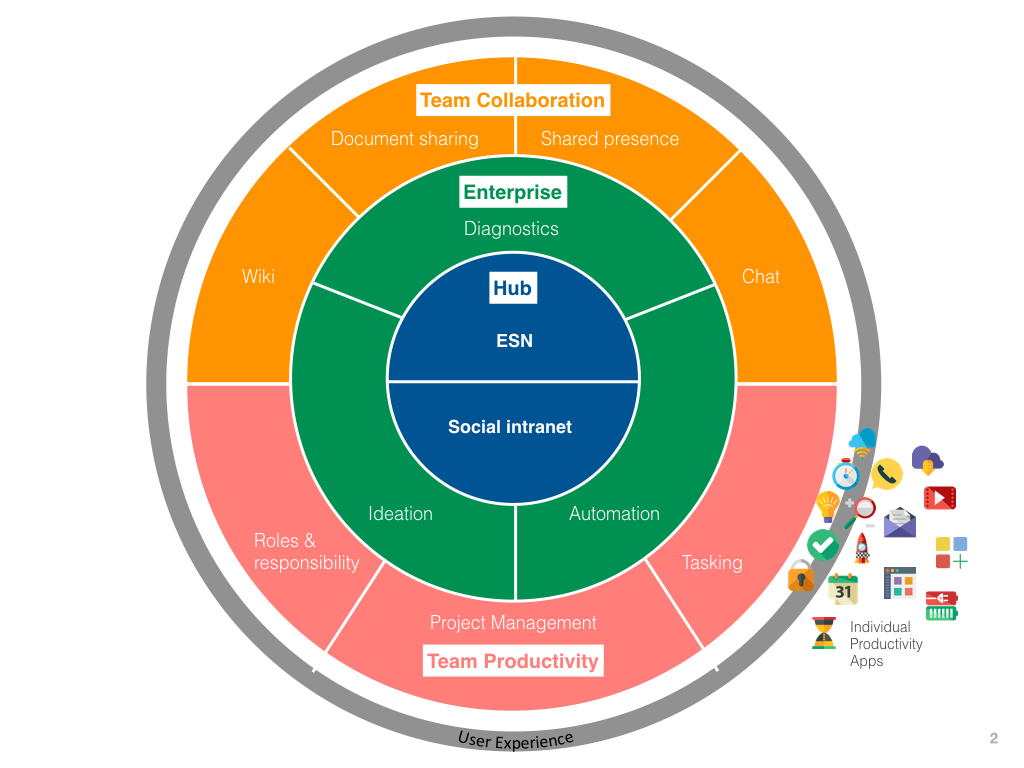This post is co-authored by Cerys Hearsey and Christine Overby. It originates in our shared experience using these tools in our Post*Shift “Living Lab,” and our shared belief that adaptive organisations will only emerge at any scale when IT and the business work together to enable a Digital Workplace Ecosystem.
All evidence suggests that people crave more autonomy and a sense of purpose at work, and that more of each is good for both business performance and employee motivation. The rise of social platforms over the last decade has given us a glimpse of the possibilities: There is something unexpectedly organic about ecosystems of people and wires. They produce an unforeseen level of connectedness that is both lateral and empowering.
But in most large organisations, the lack of a coherent ‘Future Of Work’ tech strategy thwarts any real progress. You cannot decentralise accountability and expect front-line employees to make good decisions if you do not provide them with rich data insights. And you cannot support agile, intuitive ways of working if enterprise systems reinforce brittle processes and traditional, centralised planning. To enable an adaptive organisation, both IT and the business must invest in new collaboration and communication technologies. Practically, how do you do this?
From our experience advising companies on enterprise social and digital tech decisions, we believe that the answer rests in an ecosystem approach to workplace technology. Expecting this level of collaboration from a single, monolithic platform is unrealistic, and so technology choices to enable adaptive organisations are no longer isolated decisions. The time of one platform vendor to rule them all is over, and the era of the Digital Workplace Ecosystem has arrived.
The Perils Of ‘Future Of Work’ Point Solutions
Teams across the business are not waiting for IT’s permission to find and use the technologies that they need to get the job done. Instead, they are procuring workplace technologies themselves – convinced by consumer-grade user experiences and accessible licensing models. While this crop of innovative, often small vendors do a good job enabling specialist tasks, their emergence presents a host of challenges for both IT and the business.
A Frothy Tech Market Will Frustrate Business Users
Many of the tools supporting new org structures and practices are in alpha and beta mode, and developed by start-ups at various stages of funding and viability. Business users may be delighted by the utility and ease of these tools, but the inherent challenges of an emerging tech market will prove frustrating, particularly as they seek to scale adaptive ways of working. Specific challenges include:
- A poor end-to-end user experience. While point solutions have useful interfaces for discrete tasks, no single vendor supports all the activities required to complete a project or carry out a complex task requiring different types of planning, communicating, and executing. Employees may end up needing more time to do their work as they jump from one tool to another, especially when these technologies do not share context and data.
- Difficulty finding and selecting the best tools. Business users must find the right tool for the job in a crowded, volatile tech market – we are nearing 60 vendors in our count. For most employees, technology selection does not feature into their work priorities. The combination means that employees will likely make tech decisions based upon what is convenient and known, rather than the actual best tool to get the job done.
IT And HR Must Avoid A Security And Compliance Nightmare
Most of the IT and HR executives that we work with see significant risks with new workplace point solutions, which prompts the knee-jerk reaction to stamp out shadow IT. Few tech vendors in the emerging Future Of Work market have the scale or the capacity to address these complex problems. What keeps these executives up at night? They:
- Cannot govern and track the work that gets done within point solutions. What happens if there is a security breach involving employee data shared over point solutions? How does HR take action to protect an employee who is harassed in one of these tools? These threats will only grow in magnitude as more employees across the business experiment with point solutions.
- Cannot build and scale a platform for the entire company to use. The problem is not just one of risk. Enterprises benefit from the sharing and scaling of best practices that are often first developed within a single team or business unit. It becomes harder to do this when there is no standardisation of enabling technologies.
ESNs: The Hub Of The Digital Workplace Ecosystem
Can you strike a balance between supporting business requirements, governance, and scale? We believe so. The key is a holistic approach to adaptive workplace technologies, which relies upon a flexible portfolio of integrated tools on top of a hub that offers core services such as security and integration.
The Digital Workplace Ecosystem is enabled by layers of technology:
- The Hub. An enterprise social network or robust social intranet is the best way to connect the whole organisation and communicate across its silos. Look for the hub to offer key services such as: social profiles, access and security, search, integration services, and a data lake. But don’t mistake the hub for a silver bullet technology. Its global scale is broader and less intimate than the day-to-day work context of most employees. So, you will also need solutions that support other levels of scale and intimacy – the team and the individual. As such, you should also look for your hub to support a robust and open app/bot store.
- Enterprise-level solutions. These solutions support company-wide activities that bring together employees from across the company, such as ideation and crowd-sourced innovation, or deliver services that anyone can use such as diagnostics and automation.
- Team point solutions. The key to this layer is flexibility. Some teams will prefer wiki-based collaboration to run projects, create documentation, or explore new ideas. Others might be more comfortable with a combination of real-time chat (using Slack or HipChat) combined with document sharing (Dropbox, Box, or Sharepoint if you really must). Now that integration of tools is becoming simpler, and with flexible user licensing (especially in the cloud), there is no longer a barrier to offering a variety of tools to suit different needs.
- Individual productivity tools. There is also an outer ring of individual productivity apps. These are personal for every user and cross-over between professional and personal. Examples such as the to-do list app you can’t live without, the note-taking app that simplifies your workflow or the social bookmarking app you use during your commute – we all have them. Although not formally procured by the organisation, they form part of the workplace ecosystem of your company.
The Ecosystem Needs A New Approach To Tech Decisions
You cannot apply the same technology selection approach to the various tools that make up the ecosystem. That is because this ecosystem is actually a series of Shearing Layers, each with their own decision timescales. Think of it like your smart phone. You change devices once every two to three years. You update your operating system two to three times a year, and you try new apps every couple ofweeks. Applying this layered approach to the digital ecosystem allows us to decentralise decision-making relating to the outer “fast-moving” layers and take a more considered selection process for those “slow-to-change” tools at the centre.
- Hub Solutions: Favour stability and longevity. These have the most in common with traditional technology evaluation approaches. Evaluate not only a product’s features and functions, but also the vendor’s strategy and market presence. These technologies will be in place for several years. You need stability and longevity alongside usefulness.
- Enterprise-level solutions: Prioritise integration with other tools. The way we make decisions about enterprise-level tools has a lot in common with the Hub decision. A focus on features and functions is only part of the story. The key differentiator here is the level of integration with other tools, and the number of users. There will be many who need to view the information or data, but few users. So strategy and market presence whilst informative are not as central to the decision-making process.
- Team point solutions: Go for best-of-breed. These solutions will mostly be provided by small, innovative vendors, who will appear and disappear more rapidly due to both the inherent volatility of start-ups businesses, as well as the ease in which users can switch between technologies. Here, you should prioritise best-of-breed. If a product is best-of-breed AND supported by your digital hub – either through its app/bot store or open APIs – all the better. You won’t be left in the lurch if the vendor disappears.
- Individual productivity tools: Guide the business on emerging tools. Regularly survey your employees to look for popular tools. Then include in corporate app stores to ensure currency. This approach highlights emerging individual tools that might benefit a wider audience.
Take a Use Case Approach To Building Out Stacks
You should also factor in the complete end-to-end experience for cross-tool use cases. Technology choices are traditionally made tool by tool. Any attempt to create a more holistic approach has resulted in full-stack, single vendor solutions that can frustrate the business. For example, a Microsoft-only full stack strategy (Office 365, Skype for Business and Yammer) is favourable to IT from an administration and support perspective, but involves compromises to the user experience.
A more user-centric way to do this is to use agile user stories combined with use cases and consider them across tools. Instead of listing feature and function requirements, we leverage the power of user stories (describing the results and benefits of doing something) and combine them with the detail of a use case (more granular, describing how the systems will act together to create an experience). An example would be:
Who operates at each layer?
This model provides a way to organise vendors – to aid discovery and help decision-making.

Due to the dynamic nature of this tech market – particularly at the outer levels – we expect frequent movements and additions to the Future Of Work technology space. We are keeping tabs of the vendors in our reference tracker, which we have made public to anyone looking for a way to structure their Digital Workplace Ecosystem decisions.
>> You may also be interested to read our research report on The Barriers to Digital Transformation which includes our latest thinking on organisational structures and agile attributes.


